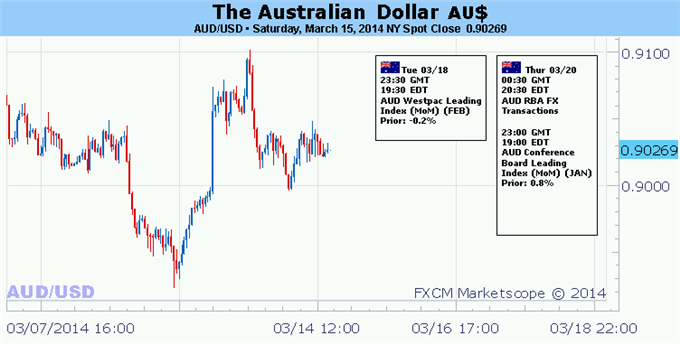US Dollar Looks to Fear, FOMC to Set Off Lasting Bull Trend
Fundamental Forecast for Dollar:Bullish
- Risk trends are starting to tremble under growth and moral hazard concerns, and definitive catalysts are seen ahead
- Janet Yellen will conduct her first FOMC policy meeting with updated forecasts and a press conference due
What will move the US dollar in the week ahead? We are awash in major fundamental catalysts – the type that can generate meaningful trends and not just short-lived bouts of volatility. With benchmark risks measures like the S&P 500, Emerging Markets and yen crosses retreating this past week, the immediate focus moving forward will be the health of global investor sentiment. And, through that day-to-day anxiety, we will also have the next FOMC rate decision complete with updated forecasts and Chairwoman Janet Yellen’s first press conference since taking the helm at the central bank.
In the known – and vague – event risk ahead, there is a clear bias for market impact that benefits the greenback. A surprise for example on the risk front would be a sentiment collapse – a substantial boost for a safe haven like the dollar. Status quo, on the other hand, is something the benchmark currency has theoretically adapted to in its relatively steady performance as of late. From a trading perspective, that translates into a far greater risk of volatility and momentum behind a dollar rally than a tumble.
That being said, we have still seen the Dow Jones FXCM Dollar Index (ticker = USDollar) decline in five of the past six weeks. A story that has gained considerable traction - though lacking for confirmation – is a move by certain major economic players to diversify away from concentrated US (Treasury and dollar) exposures. This past Friday, it was reported that securities held in custody for foreign accounts plunged more than $100 billion – the biggest drop on record. Many speculate this could have been a move by Russia in response to the Crimea situation. This dramatic move aside, the diversification move has been a slow development for some time. The monthly international capital flows account (TIC) has shown net outflow from the US in eight of the last 12 months. And, China has been a big part of this move, with a supposed appetite for Eurozone exposure – hence the EURUSD’s ability to grind out steady gains.
The most effective way to halt this diversification in the near-term is for a bolt of fear to rip through the global financial markets. Though the effort to spread exposure is itself a move to reduce risk, a true deleveraging of mature speculative positions and scramble for liquidity would send investors to the dollar. Whether an unwind from emerging markets and Eurozone periphery or evasion of a credit market squeeze, the dollar is a beacon through panic. The spark that can effectively incite fear is therefore our primary concern.
We have already seen evidence these past weeks that the markets are on edge and sensitive to bigger flights to safety. Headlines that contribute to China’s slowing economy or lending market troubles, a moral hazard seizure due to a universal lean away from stimulus, or recognition of leveraged risk could effectively jump start a watershed change in positioning. Yet, these have been issues for some time. More isolated and perhaps destabilizing may be another emerging market shock. Following the India-based risk move last year and Turkey concerns in late January, the concern now is the standoff between Russia and the Western world over the Crimea region of Ukraine. With a referendum vote - on whether to join Russia – due over the weekend, this is certainly a hot spot for ‘risk’ trends.
While reviving the safe haven status of the dollar through an extreme need is the most effective means for reviving the currency’s strength, there is also potential for the FOMC rate decision on Wednesday to spur appetite. This is one of the quarterly meetings whereby updated forecasts for growth, inflation and interest rates are due. Furthermore, this will be the first time Janet Yellen will speak in her new role as the head of the central bank. The baseline expectation is for a continued Taper – so confirming this view may carry little shock value. The next steps of speculation in this event risk is starting to shape the time line for the first rate hike. The market will start speculating and positioning for the return to rate hikes well before the first move is announced…


 LinkBack URL
LinkBack URL About LinkBacks
About LinkBacks







 Reply With Quote
Reply With Quote





Bookmarks